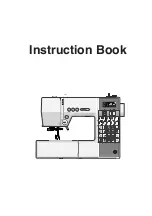
Names of Machine Parts and Their Functions
B-4
Operation buttons
1
“Start/Stop” button
Press the “Start/Stop” button to start or stop sewing. The
machine stitches at a slow speed at the beginning of sewing
while the button is pressed. When sewing is stopped, the
needle is lowered in the fabric. For details, refer to “STARTING
TO SEW” on page B-35.
The button changes color according to the machine’s
operation mode.
2
Reverse stitch button
For straight, zigzag, and elastic zigzag stitch patterns that use
reverse stitches, the machine will sew reverse stitches at low
speed only while holding down the Reverse stitch button. The
stitches are sewn in the opposite position.
For other stitches, use this button to sew reinforcement
stitches at the beginning and end of sewing. Press and hold
this button, and the machine sews 3 stitches in the same spot
and stops automatically. (page B-39)
3
Reinforcement stitch button
Use this button to sew a single stitch repeatedly and tie-off.
For character/decorative stitches, press this button to end with
a full stitch instead of at a mid-point. The LED light beside this
button lights up while the machine is sewing a full motif, and
automatically turns off when the sewing is stopped. (page B-
38)
4
Needle position button
Press the needle position button to raise or lower the needle.
Pressing the button twice sews one stitch.
5
Thread cutter button
Press the thread cutter button after sewing is stopped to cut
both the upper and the bobbin threads. For details, refer to
step
l
under the “Sewing a stitch” section on page B-36.
6
Presser foot lifter button
Press this button to lower the presser foot and apply pressure
to the fabric. Press this button again to raise the presser foot.
7
Sewing speed controller
Slide the sewing speed controller to adjust the sewing speed.
Operation panel and operation keys
1
LCD (liquid crystal display) (touch panel)
Selected pattern settings and messages are displayed.
Touch the keys displayed on the LCD to perform operations.
For details, refer to “LCD Operation” on page B-11.
2
Previous page key
Displays the previous screen when there are items that are not
displayed on the LCD.
3
Next page key
Displays the next screen when there are items that are not
displayed on the LCD.
4
Help key
Press to get help on using the machine.
5
Settings key
Press to set the needle stop position, the buzzer sound, and
more.
6
Embroidery key
Press this key to sew embroidery.
7
Utility stitch key
Press this key to select a utility stitch or decorative stitch.
8
Back key
Press to return to the previous screen.
9
Presser foot/Needle exchange key
Press this key before changing the needle, the presser foot,
etc. This key locks all key and button functions to prevent
operation of the machine.
Green:
The machine is ready to sew or is sewing.
Red:
The machine can not sew.
Orange:
The machine is winding the bobbin thread, or
the bobbin winder shaft is moved to the right
side.
CAUTION
• Do not press
(Thread cutter button) after
the threads have already been cut, otherwise
the needle may break, the threads may
become tangled or damage to the machine
may occur.
b
c
d e f
a
g
Note
• The operation keys of this machine are
capacitive touch sensors. Operate the keys by
directly touching them with your finger.
The response of the keys varies according to the
user. The pressure exerted on the keys does not
affect the response of the keys.
• Since the operation keys react differently
depending on the user, adjust the setting for
“Adjusting input sensitivity for operation keys” on
page B-16.
• When using an electrostatic touch pen, make
sure that its point is 8 mm or more. Do not use a
touch pen with a thin point or a unique shape.
a
b
c
d
e
f
g
h
i
Содержание 888-G00
Страница 2: ......
Страница 76: ...Embroidering B 66 ...
Страница 122: ...Decorative Stitching S 46 ...
Страница 182: ...Using the Memory Function E 36 ...















































